Introduction
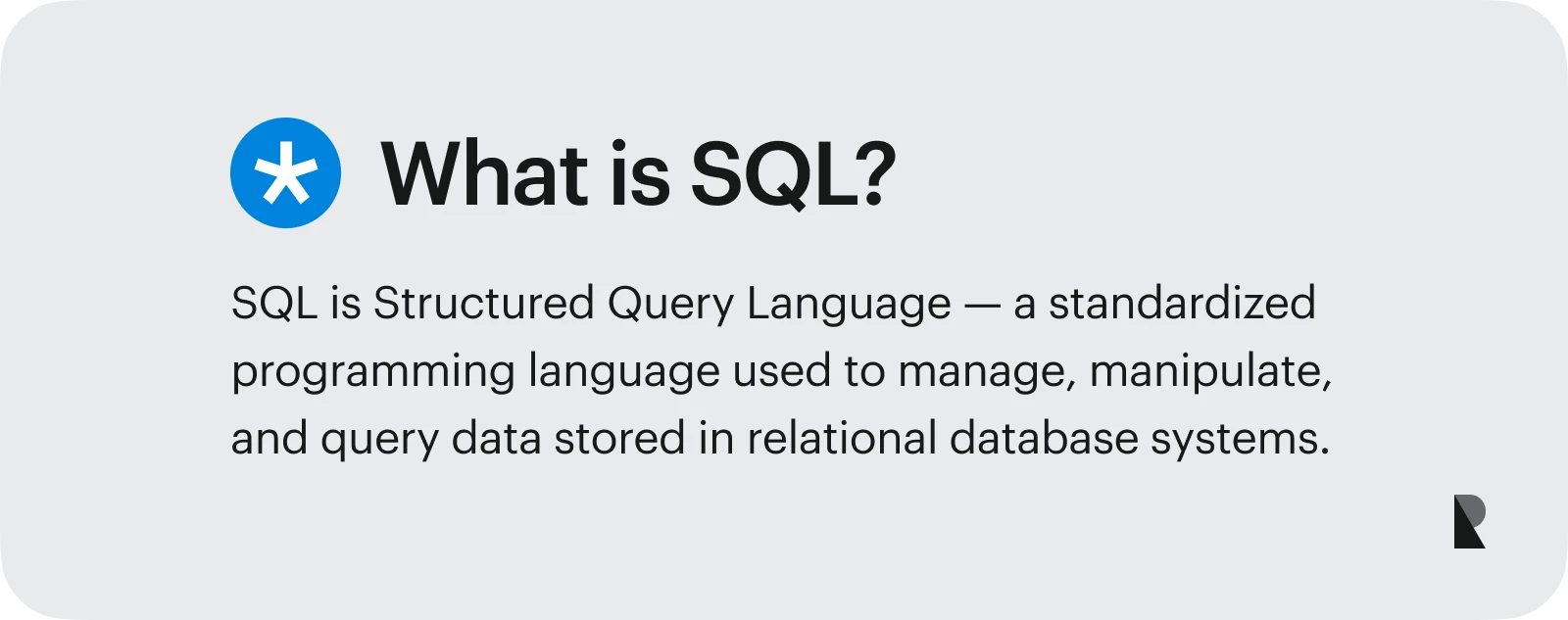
Choosing between SQL and NoSQL is one of the most consequential technical decisions developers face when building modern applications. For any team evaluating database options, this decision directly affects scalability, performance, and long-term maintainability.
While SQL databases are table-based and follow ACID properties (Atomicity, Consistency, Isolation, and Durability), NoSQL databases can be document-based, key-value, column-family, or graph-based, following the Brewer's CAP theorem instead.
The differences extend beyond structure. SQL databases are vertically scalable, requiring hardware upgrades on a single server to increase capacity. Conversely, NoSQL databases offer horizontal scalability, allowing developers to add more servers to handle increased data loads.
This guide examines both database systems in depth to help determine which actually fits your project requirements. For teams planning a new product or those considering hiring a web development application company, understanding these database fundamentals ensures more informed collaboration and technical alignment. Whether you're building data-intensive applications, real-time web services, or enterprise systems, understanding each database type's strengths, limitations, and use cases will guide you toward making the optimal choice for your specific needs.
What Is SQL and How Relational Databases Work
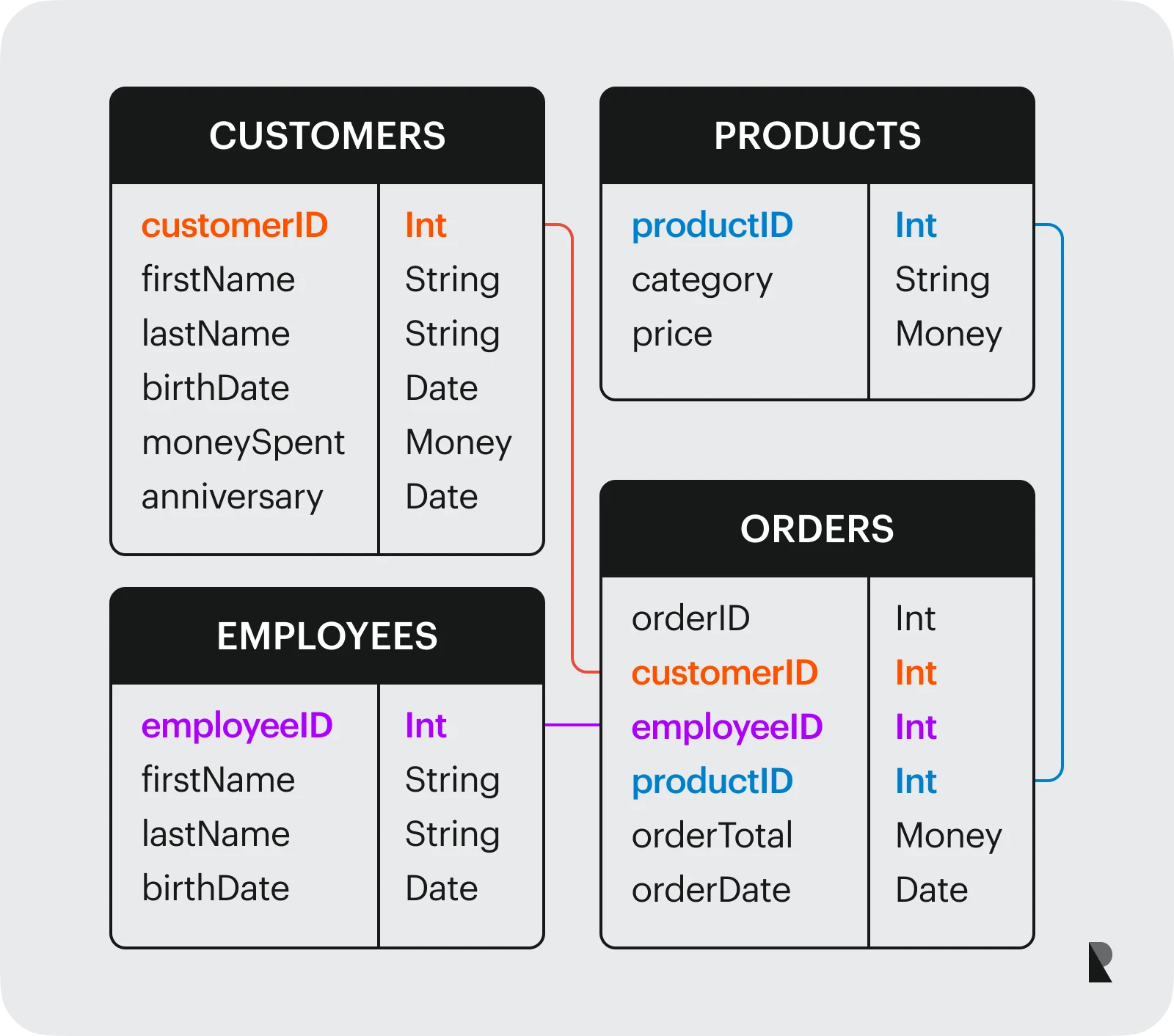
Working of SQL (Image Source)
Structured Query Language (SQL) originated at IBM in the 1970s as a standardized way to interact with relational databases. Known initially as SEQUEL (Structured English Query Language), SQL evolved into the universal language for managing and manipulating data stored in relational database management systems (RDBMS).
Relational databases organize information into tables containing rows (records) and columns (attributes), similar to spreadsheets. However, their power lies in the relationships established between these tables. Each table typically includes a primary key and a unique identifier for each record. It may also reference other tables through foreign keys, creating meaningful connections between data sets.
The foundation of relational databases stems from mathematical principles proposed by Dr. Edgar F. Codd in his 1970 paper "A Relational Model of Data for Large Shared Data Banks." This model revolutionized data storage by organizing information based on relationships rather than hierarchical structures.
Key features of SQL databases
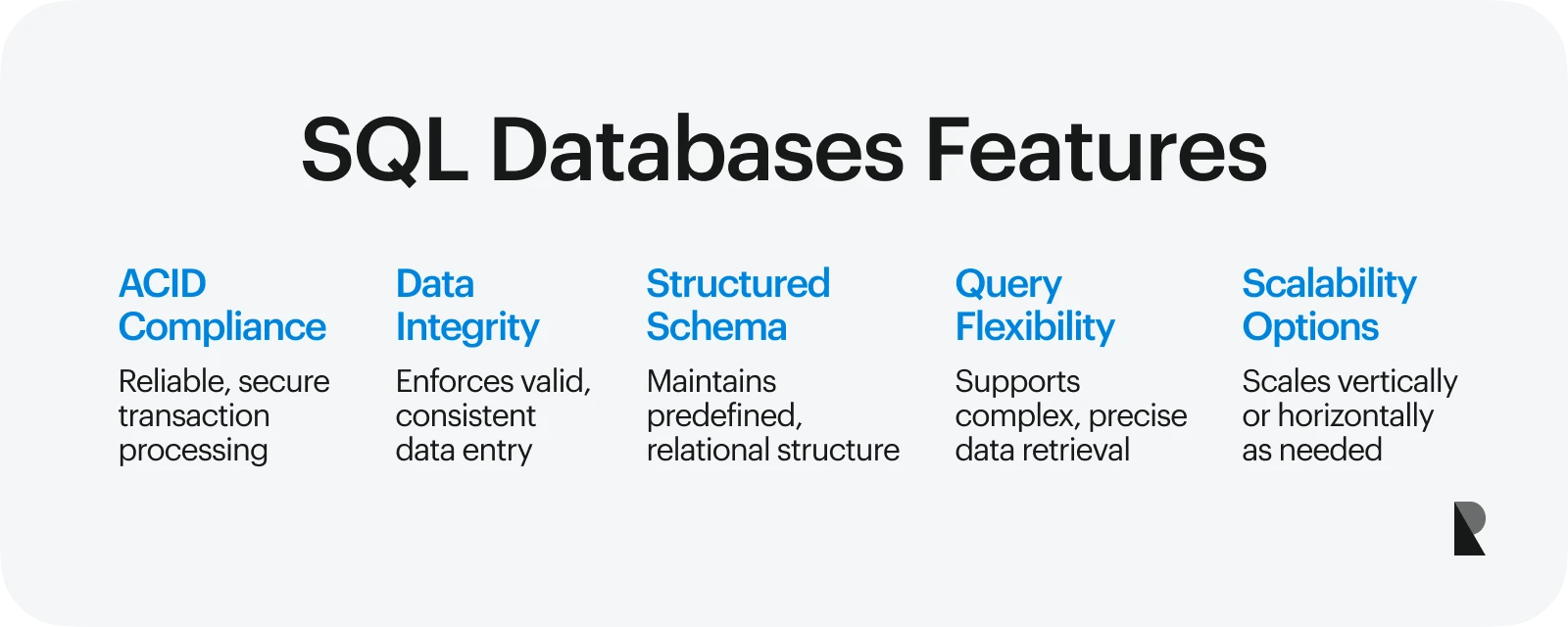
SQL databases excel through several distinctive characteristics that make them powerful tools for data management:
- ACID compliance: SQL databases adhere to Atomicity, Consistency, Isolation, and Durability properties, ensuring transactions are processed reliably and securely. This makes them ideal for data integrity applications like financial systems and e-commerce platforms.
- Data integrity: SQL databases prevent invalid or inconsistent data entry through constraints and referential integrity checks. These mechanisms maintain relationships between tables and avoid orphaned or disconnected information.
- Structured schema: Relational databases enforce predefined schemas with explicit dependencies between data points, enabling complex operations while maintaining data consistency.
- Query flexibility: SQL supports various operations, including joins, subqueries, and conditional statements, allowing users to retrieve specific information from large datasets. This flexibility empowers complex data analysis tasks without extensive programming.
- Scalability options: Though primarily scaled vertically (upgrading hardware on a single server), many modern SQL implementations offer horizontal scaling solutions for growing data requirements.
Popular SQL databases
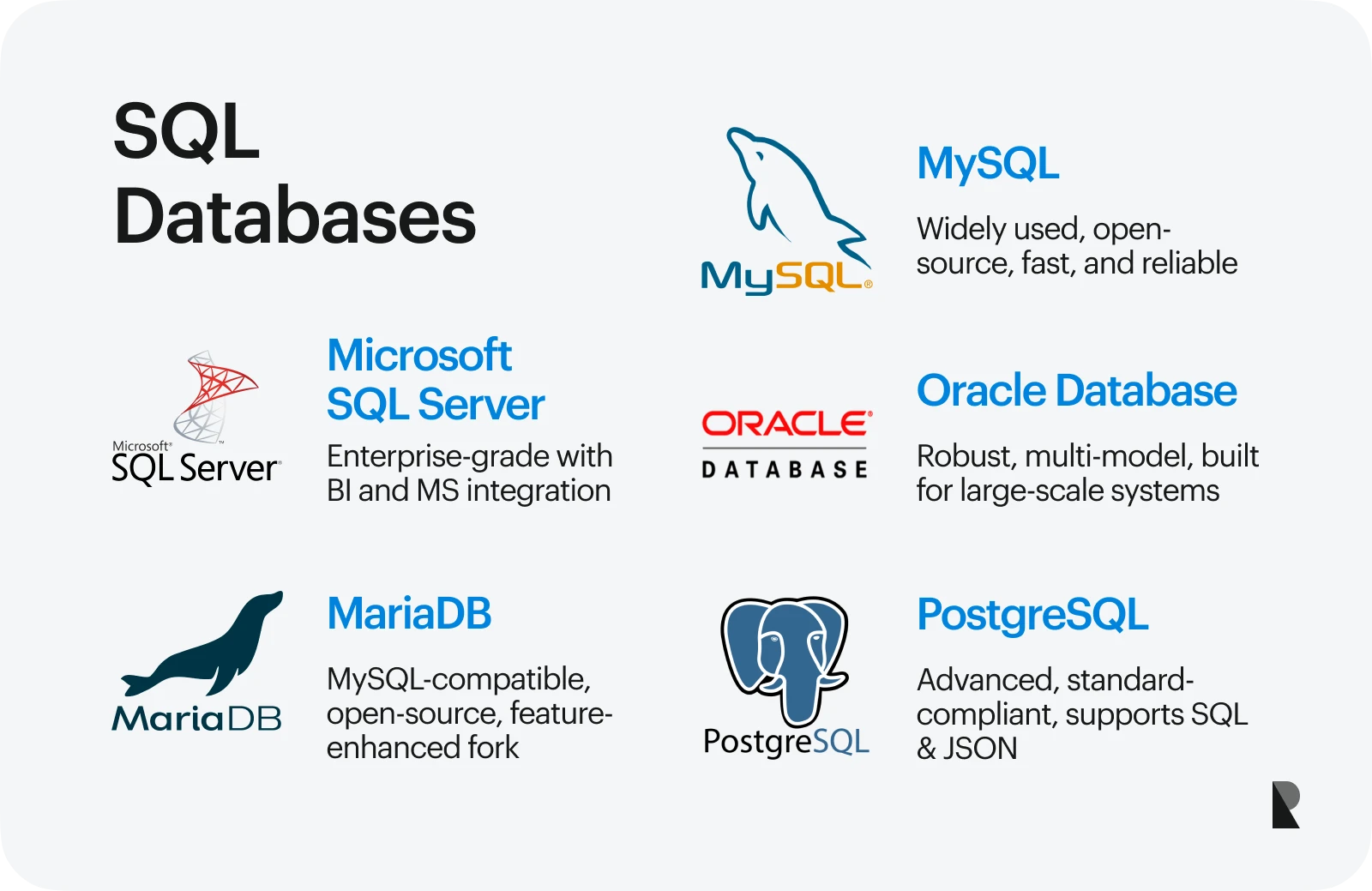
The SQL database ecosystem features several major players, each with distinct strengths:
MySQL - An open-source RDBMS powering many world-famous applications, including YouTube, Facebook, Twitter, and Netflix. Its reliability, performance, and ease of use have made it one of the most widely deployed database systems worldwide.
PostgreSQL - An advanced object-relational database management system providing robust features and close compliance with SQL standards. PostgreSQL supports SQL (relational) and JSON (non-relational) querying, offering exceptional flexibility.
Microsoft SQL server - A commercial RDBMS developed by Microsoft, available in multiple editions for different use cases. It features strong integration with other Microsoft products and comprehensive business intelligence capabilities.
Oracle database - One of the oldest and most established commercial database systems, Oracle excels in high-volume transaction processing and data warehousing applications. It offers multi-model support within a single database architecture.
MariaDB - A community-developed fork of MySQL created by MySQL's original developers. MariaDB maintains compatibility with MySQL while offering additional features and improvements.
What Is NoSQL and How It Differs
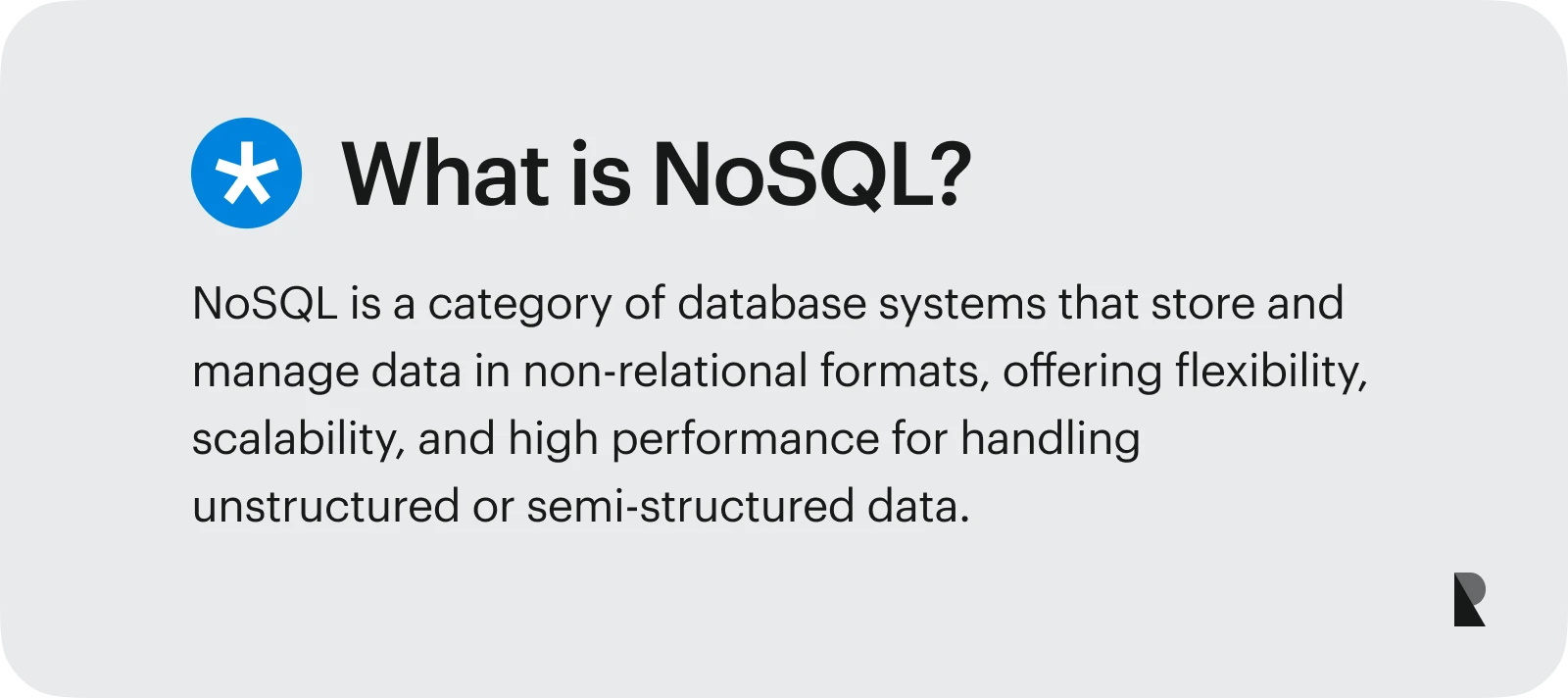
NoSQL databases emerged as an alternative approach to data management, primarily in response to the limitations of traditional relational models. The term "NoSQL" meant initially "non-SQL" but has evolved to represent "Not Only SQL," acknowledging that these systems complement rather than replace SQL databases entirely.
Unlike their rigid, table-based counterparts, NoSQL databases store information in flexible formats that accommodate various data types without requiring predefined schemas. This design philosophy prioritizes scalability, speed, and agility over the strict consistency guarantees offered by relational systems.
Key features of NoSQL databases
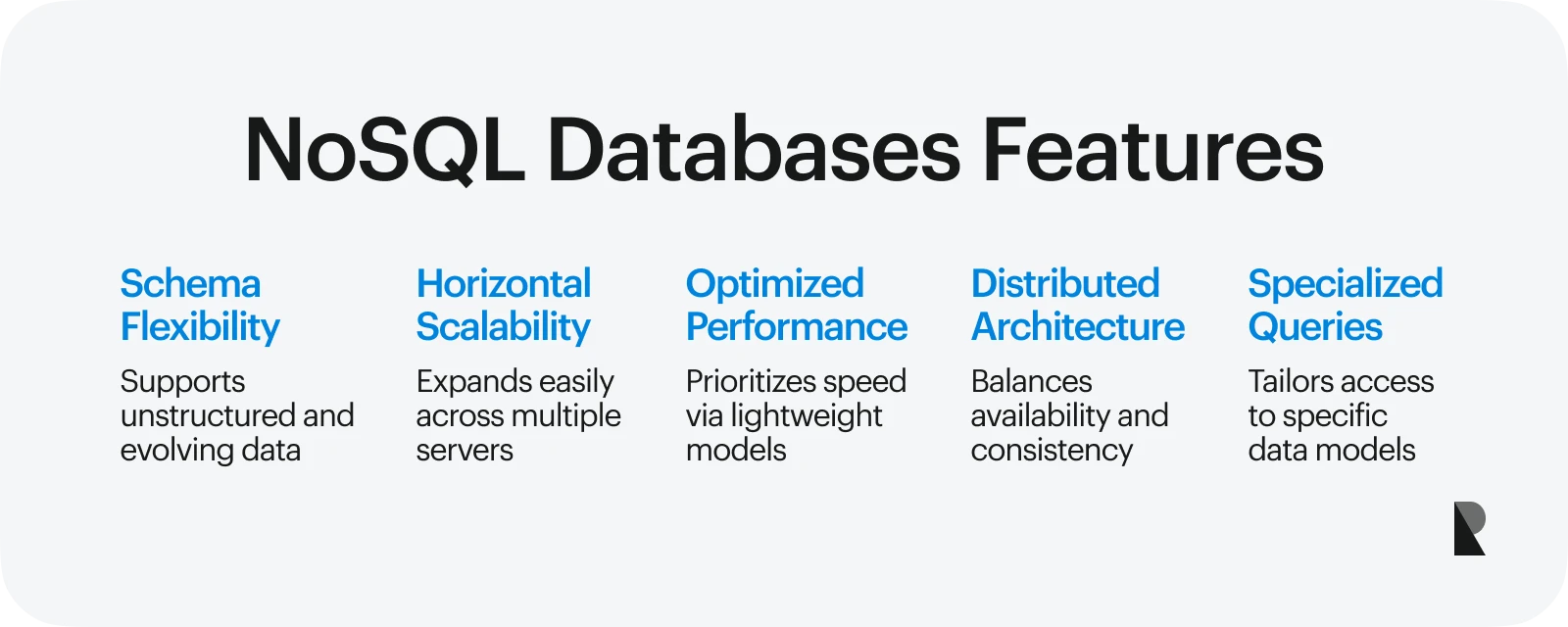
NoSQL databases share several distinctive characteristics that set them apart from traditional relational models:
Schema flexibility: NoSQL databases allow developers to store unstructured or semi-structured data without declaring a fixed schema beforehand. Fields can be added on the fly without disrupting existing records, enabling rapid application development and iteration.
Horizontal scalability: Most NoSQL solutions automatically distribute data across multiple servers. This "scale-out" approach allows systems to handle massive data volumes and user loads by adding more commodity machines to the cluster.
Optimized performance: NoSQL databases achieve remarkable speed for specific use cases by sacrificing some ACID guarantees. Many NoSQL implementations utilize in-memory caching, simplified query models, and optimized storage formats to deliver impressive performance.
Distribution models: NoSQL databases often implement distributed architectures based on the CAP theorem (Consistency, Availability, Partition tolerance). Typically, these systems prioritize availability and partition tolerance over strict consistency.
Specialized query methods: Each NoSQL variant offers query capabilities tailored to its data model. From document-specific query languages to simple key-value lookups, these methods optimize for particular access patterns.
Examples of NoSQL databases
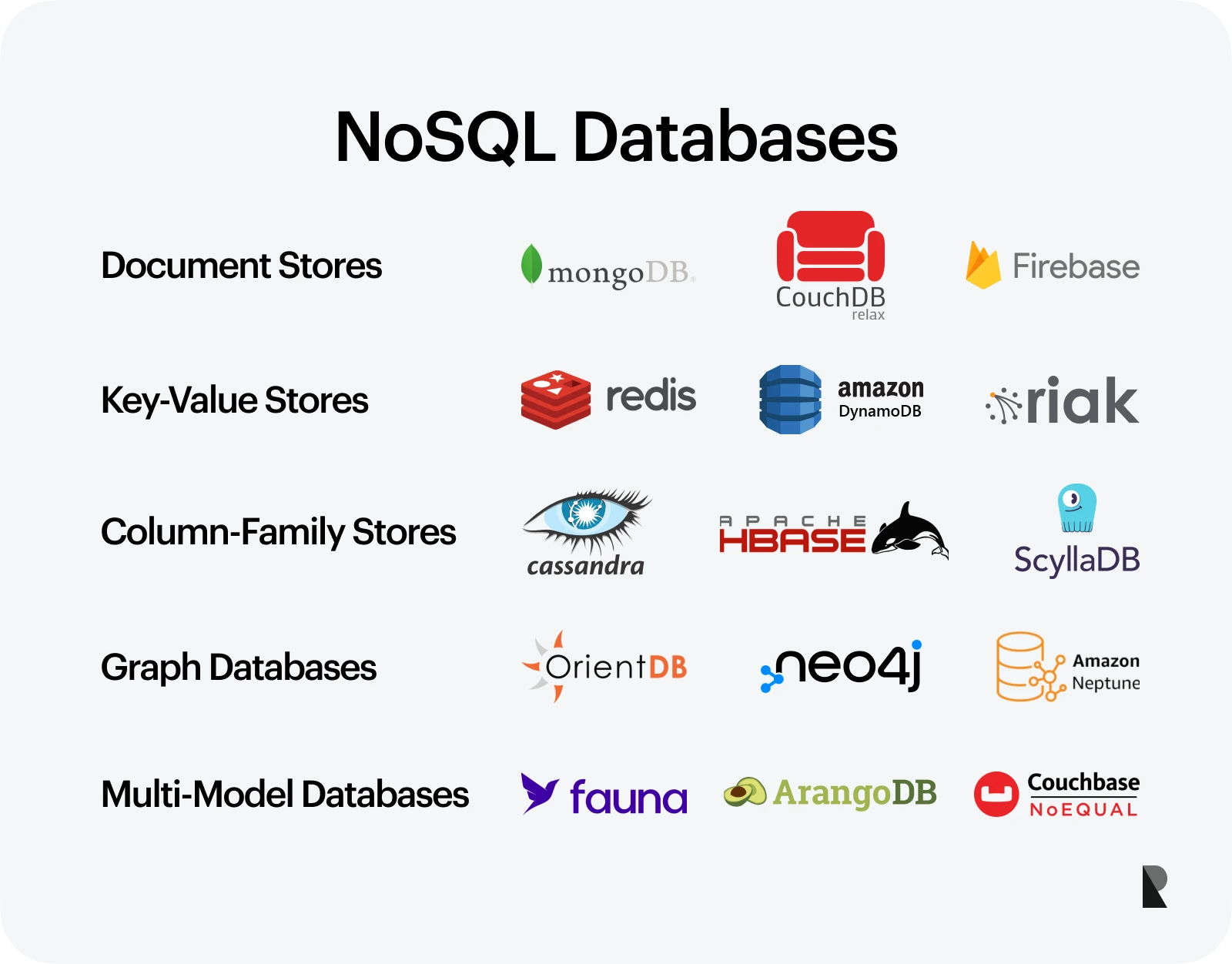
NoSQL databases fall into four primary categories, each designed for specific use cases:
Document stores: MongoDB and CouchDB store data as JSON-like documents. These systems excel at managing semi-structured content such as user profiles, product catalogs, and content management systems.
Key-value stores: Redis and Amazon DynamoDB provide simple yet lightning-fast storage through key-value pairs. They're particularly effective for caching, session management, and high-throughput data access scenarios.
Column-family stores: Cassandra and HBase organize related data in column families rather than rows. This design delivers exceptional performance for time-series data, recommendation engines, and systems requiring massive write capacity.
Graph databases: Neo4j and Amazon Neptune specialize in representing complex relationships between data points. These systems excel at handling highly connected information, such as social networks, fraud detection systems, and recommendation engines.
Beyond these categories, several multi-model databases, like ArangoDB and FaunaDB, have emerged. These databases offer multiple data models within a single system to address diverse application requirements.
SQL vs. NoSQL: Key Differences
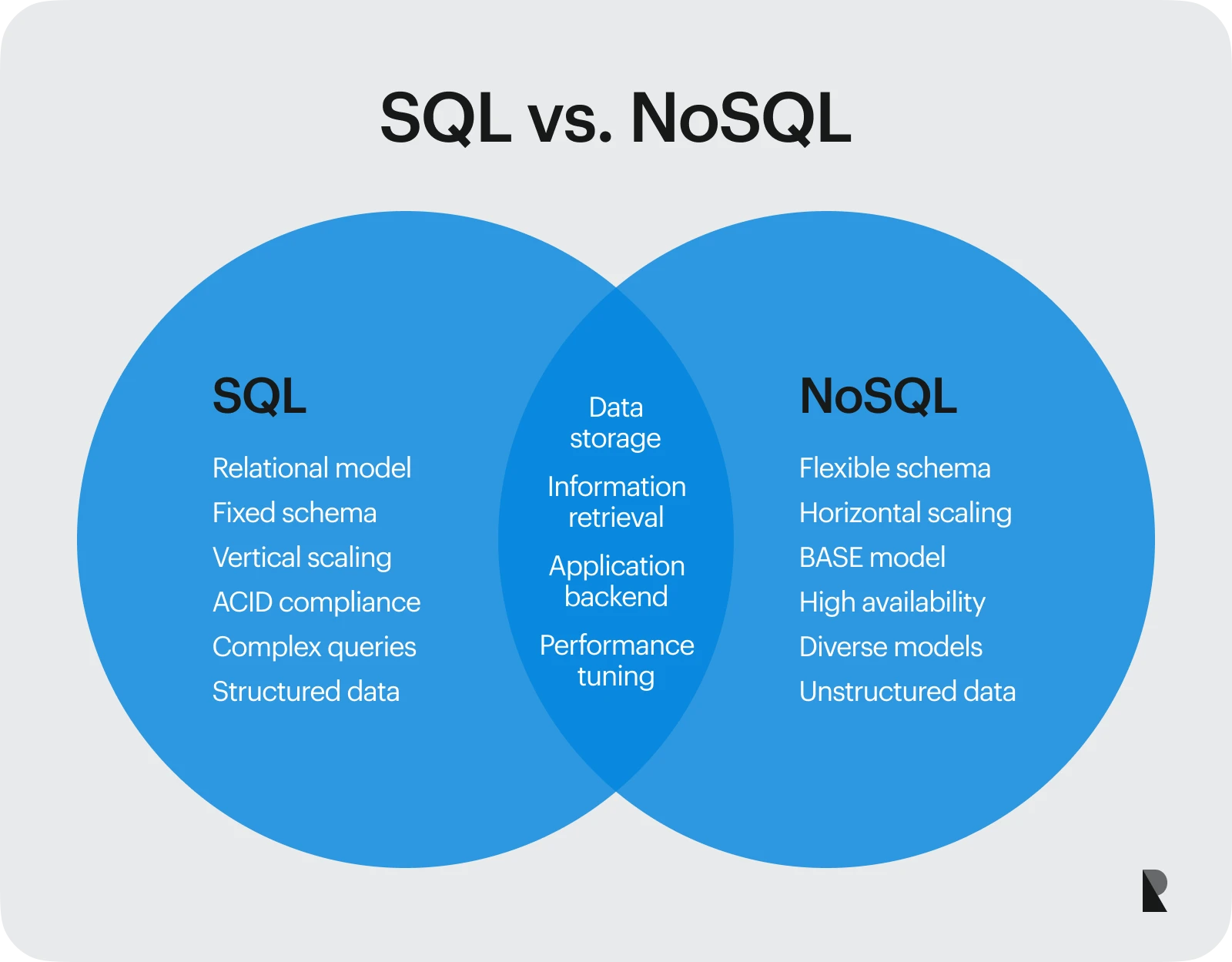
The fundamental differences between SQL and NoSQL extend beyond their names and reflect distinct philosophies in database design. Understanding these key differences helps developers decide which database system best suits their application needs.
Data models
SQL databases follow the relational model, organizing data into tables with rows and columns that maintain relationships through primary and foreign keys. These structured relationships allow for normalized data storage and complex joins across multiple tables.
In contrast, NoSQL databases utilize various data models depending on their type: document stores organize data in JSON-like documents; key-value stores use simple key-value pairs; column-family stores arrange data by column rather than row; additionally, graph databases prioritize relationships between entities as their fundamental structure.
Schema flexibility
One of the most significant distinctions lies in schema handling. SQL databases require a predefined schema before data insertion, enforcing consistency by validating data types, relationships, and constraints. This rigidity ensures data integrity yet makes structural changes complex and potentially disruptive.
Alternatively, NoSQL databases embrace schema flexibility, allowing documents within the same collection to have different fields. This dynamic approach enables rapid application development, especially for projects with evolving requirements or handling diverse data types.
Scalability
Regarding scaling approaches, SQL databases traditionally scale vertically by adding more resources (CPU, RAM) to a single server, which eventually faces physical and economic limitations. NoSQL databases, meanwhile, typically scale horizontally by distributing data across multiple servers, offering theoretically unlimited growth potential.
This fundamental difference makes NoSQL particularly suitable for applications expecting significant data volume increases or requiring geographic data distribution.
Query language
SQL databases utilize the standardized Structured Query Language, providing powerful tools for complex data manipulation, aggregation, and joins. Consequently, they excel at complex reporting and data analysis tasks.
Conversely, NoSQL systems employ various query methods based on their specific data models, from MongoDB's document-oriented query language to simple key lookups in Redis or Cassandra's CQL. These specialized approaches often deliver faster performance for specific use cases at the expense of standardization.
Transactions
SQL databases generally provide robust ACID (Atomicity, Consistency, Isolation, Durability) compliance, ensuring data validity even during failures. Accordingly, they remain the standard for financial applications and systems requiring strict data integrity.
NoSQL databases frequently favor the BASE model (Basically Available, Soft state, Eventually consistent), prioritizing availability and partition tolerance over immediate consistency. This makes them suitable for applications where eventual consistency is acceptable.
Use cases
SQL databases typically shine in scenarios requiring complex transactions, strict data integrity, or established schemas, such as financial systems, inventory management, and traditional business applications.
Fundamentally, NoSQL databases excel where flexibility, scalability, and performance are paramount, including content management, real-time analytics, IoT applications, and systems handling large volumes of rapidly changing semi-structured or unstructured data.
When to Use SQL
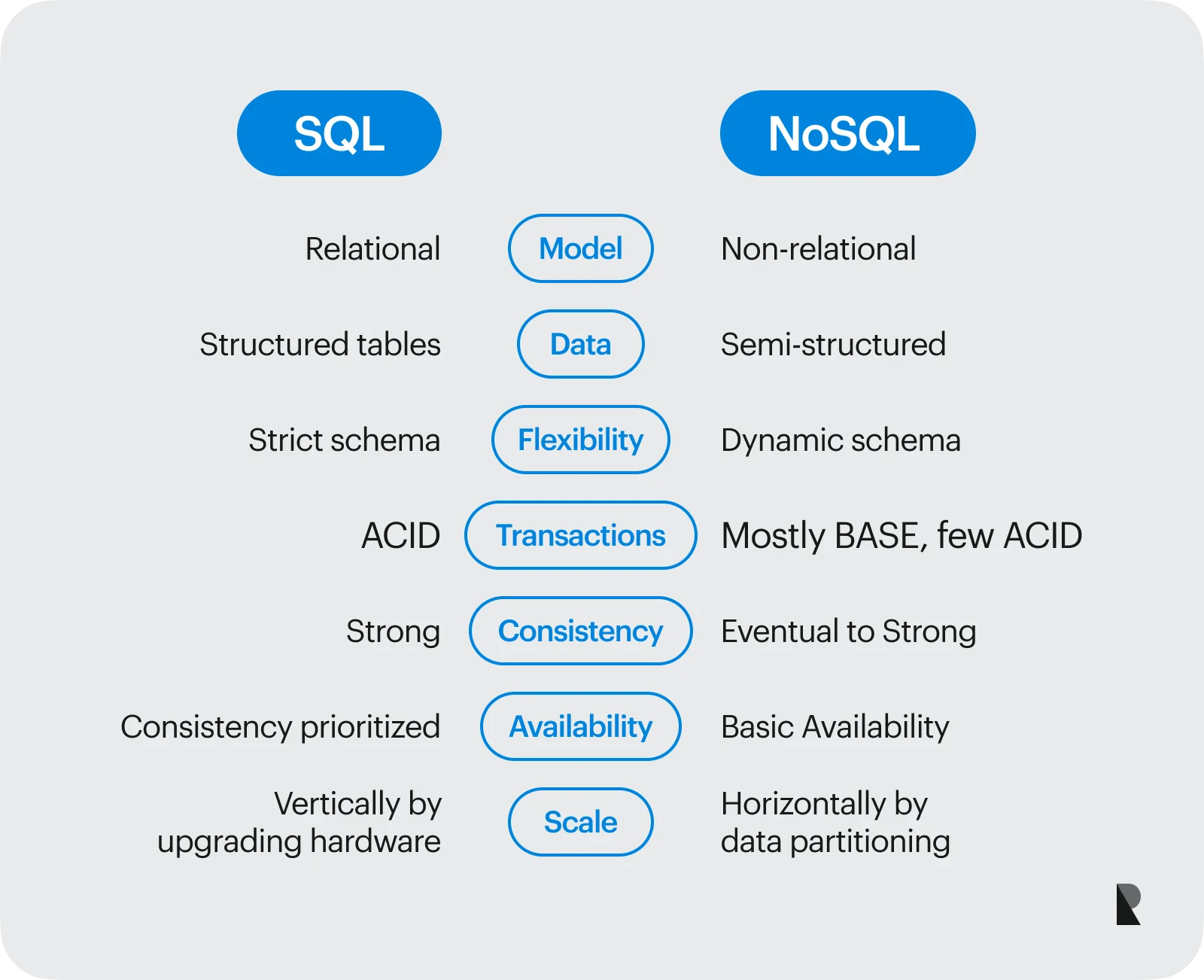
SQL databases remain indispensable in the modern technological landscape despite the rising popularity of alternative solutions. Implementing a relational database system stems from several specific project requirements and data characteristics.
SQL databases offer unmatched benefits for applications handling structured, predictable data with fixed relationships. Financial applications and banking systems gravitate toward SQL solutions because they demand strict data consistency and integrity.
These systems' ACID compliance ensures that transactions are processed reliably even during failures, making them ideal for scenarios where data accuracy cannot be compromised.
E-commerce platforms benefit from SQL's strengths in managing transactional data, orders, payments, and inventory. The referential integrity checks prevent invalid data entry, maintaining the critical relationships between products, customers, and orders that power these systems.
Business intelligence applications thrive with SQL databases since they excel at complex reporting and data aggregation tasks. SQL's powerful querying capabilities enable analysts to extract precise insights, generate comprehensive reports, and support informed decision-making across operations, HR, sales, and marketing departments.
Healthcare systems also leverage SQL for patient record management and medical history storage. The structured nature of medical data, with well-defined relationships between patients, treatments, and outcomes, aligns perfectly with the relational model.
Moreover, SQL databases shine in scenarios requiring space optimization through normalization. Reducing data redundancy becomes crucial when managing large volumes of structured information, hence saving considerable storage costs.
Enterprise-level applications with complex data relationships furthermore benefit from SQL's standardized approach. The widespread adoption of SQL has created a robust ecosystem of tools, documentation, and professional expertise, making implementation and maintenance more straightforward.
SQL databases still represent the optimal choice if your project involves predictable data structures, requires multi-row transactions, or needs strong consistency guarantees. Their decades of refinement and optimization have created reliable systems that handle mission-critical applications where data integrity reigns supreme.
When to Use NoSQL
NoSQL databases thrive in specific modern application scenarios where traditional relational approaches fall short. Projects dealing with massive amounts of unstructured or semi-structured data benefit immensely from NoSQL's flexible schema approach.
Social media platforms, for instance, handle diverse content types, including posts, comments, reactions, and metadata, all with varying attributes that would be cumbersome to manage in rigid table structures.
Real-time big data applications represent another perfect fit for NoSQL solutions. These systems simultaneously excel at processing high-velocity information streams from multiple sources without performance degradation. IoT deployments similarly leverage NoSQL databases to ingest vast quantities of sensor data at scale.
Content management systems primarily utilize NoSQL when flexibility matters most. As websites evolve and content requirements change, document databases allow developers to add new fields without disrupting existing records, eliminating migration headaches common with SQL systems.
Gaming applications notably benefit from NoSQL's performance advantages. Player profiles, game states, and leaderboards demand rapid access and frequent updates, areas where key-value stores shine brightly.
Geographic distribution requirements point toward NoSQL as well. Applications serving global audiences need data replicated across multiple regions, a capability built into many NoSQL systems from the ground up.
Undeniably, NoSQL excels whenever application development speed outweighs rigid data consistency, particularly for minimum viable products and rapidly iterating startups.
SQL + NoSQL Hybrid Approach
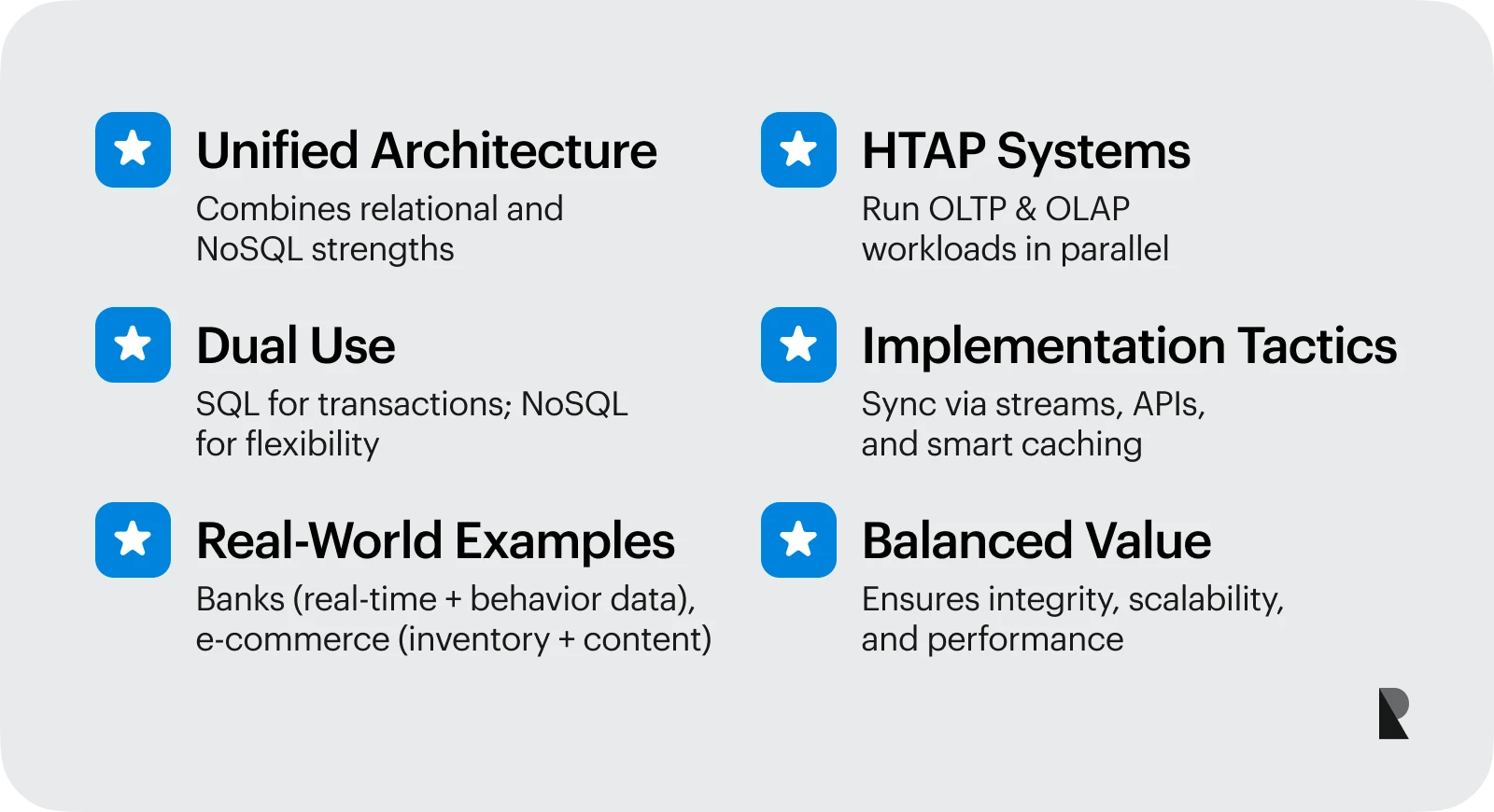
Beyond the either-or debate between SQL and NoSQL databases, many organizations now adopt hybrid approaches that blend both technologies. This pragmatic strategy allows teams to leverage the strengths of each database paradigm within a single application ecosystem.
The hybrid database model employs relational and NoSQL methods in a unified architecture, gaining advantages from both worlds. Financial institutions utilize this approach to process real-time transactions via SQL while analyzing customer behavior patterns through NoSQL.
E-commerce platforms frequently implement SQL databases for inventory management and payment processing alongside NoSQL solutions for product catalogs and user-generated content.
HTAP (Hybrid Transactional and Analytical Processing) is at the technical core of hybrid systems, enabling parallel execution of OLTP and OLAP workloads. This architecture supports both row-based and column-based storage optimization, creating an efficient platform where data resides in formats best suited for specific operations.
Implementation strategies include data synchronization through change streams and Lambda functions, API layers directing queries to appropriate databases based on complexity, and strategic caching policies. The ultimate goal remains consistent, positioning each database type where it delivers maximum value according to its inherent characteristics.
Through this balanced approach, businesses maintain data integrity where required without sacrificing the flexibility and scalability essential for modern applications.
Conclusion
Choosing between SQL and NoSQL databases ultimately depends on your project's requirements rather than following trendy technology preferences. SQL databases excel at managing structured data with complex relationships, providing robust ACID compliance for applications where data integrity cannot be compromised.
Conversely, NoSQL solutions shine when dealing with massive volumes of unstructured or semi-structured data, horizontal scalability needs, and rapid development cycles. Social media platforms, IoT systems, and content management applications thus find NoSQL databases particularly advantageous due to their flexibility and performance characteristics.
The emergence of hybrid approaches demonstrates how the database landscape has matured beyond the false SQL-versus-NoSQL dichotomy. Many sophisticated systems combine both technologies, allowing teams to utilize SQL for transactional components while employing NoSQL for analytics, user-generated content, or caching layers.
This pragmatic strategy enables organizations to match each database type to specific workloads where its inherent strengths deliver maximum value.
As data volumes grow and application requirements become increasingly complex, database selection becomes a nuanced decision requiring careful consideration of data structure, consistency requirements, scaling needs, and development timelines.
Successful organizations evaluate these factors objectively, selecting the right tool for each data challenge rather than committing exclusively to either paradigm. The most effective database strategy often involves understanding the strengths and limitations of both SQL and NoSQL systems and applying this knowledge strategically across the technology stack.
Oct 9, 2025
